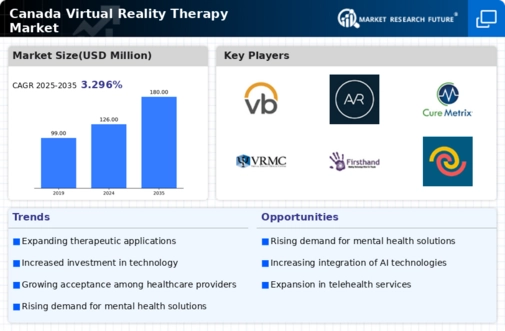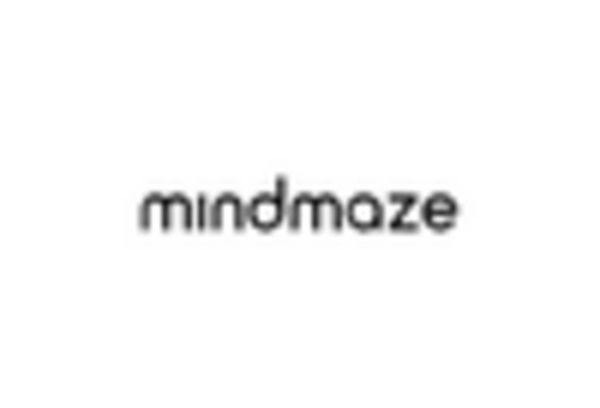Support from Healthcare Institutions
Healthcare institutions in Canada are increasingly recognizing the potential of virtual reality as a therapeutic tool. This support is crucial for the growth of the virtual reality-therapy market, as institutions are beginning to integrate VR into their treatment protocols. Notably, hospitals and clinics are allocating budgets for innovative therapies, with some institutions reporting investments of up to $500,000 in VR technology for mental health programs. This institutional backing not only legitimizes the use of VR in therapy but also encourages further research and development in the field. As more healthcare providers adopt VR solutions, the market is expected to expand, driven by the need for effective and engaging treatment options that can enhance patient outcomes.
Rising Popularity of Telehealth Services
The increasing popularity of telehealth services in Canada is another key driver for the virtual reality-therapy market. As more patients seek remote therapy options, the integration of VR into telehealth platforms appears to offer a unique solution that combines the benefits of virtual interaction with immersive therapeutic experiences. Current estimates suggest that telehealth usage has surged by over 50% in recent years, indicating a shift in how mental health services are delivered. This trend is likely to continue, as patients appreciate the convenience and accessibility of remote therapy. The virtual reality-therapy market stands to benefit from this shift, as practitioners can leverage VR technology to enhance telehealth sessions, providing patients with engaging and effective treatment options from the comfort of their homes.
Growing Awareness of Mental Health Issues
In recent years, there has been a marked increase in awareness surrounding mental health issues in Canada. This societal shift is driving demand for innovative treatment options, including those offered by the virtual reality-therapy market. As more individuals seek help for conditions such as anxiety, depression, and PTSD, the need for effective therapeutic solutions becomes paramount. Reports indicate that approximately 1 in 5 Canadians experience mental health challenges, highlighting the urgency for accessible treatment methods. The virtual reality-therapy market is well-positioned to address this need, offering unique, engaging, and effective therapeutic experiences that resonate with a tech-savvy population. This growing awareness is likely to propel the market forward, as both practitioners and patients recognize the potential benefits of VR in therapy.
Technological Advancements in VR Equipment
The rapid evolution of virtual reality technology is a pivotal driver for the virtual reality-therapy market. Enhanced hardware capabilities, such as improved graphics and motion tracking, are making VR experiences more immersive and effective. In Canada, the market for VR equipment is projected to grow significantly, with estimates suggesting a compound annual growth rate (CAGR) of around 30% over the next five years. This technological progress not only enhances user experience but also broadens the scope of applications in therapeutic settings, making VR a more appealing option for mental health professionals. As VR equipment becomes more accessible and affordable, its integration into therapeutic practices is likely to increase, thereby expanding the virtual reality-therapy market in Canada.
Increased Funding for Mental Health Initiatives
The Canadian government and various organizations are increasingly allocating funds to mental health initiatives, which is a significant driver for the virtual reality-therapy market. Recent budgets have seen a rise in mental health funding by approximately 10%, reflecting a commitment to improving mental health services across the country. This financial support is crucial for the development and implementation of innovative therapies, including those utilizing virtual reality. As funding becomes more available, research institutions and therapy providers are likely to explore VR applications more thoroughly, potentially leading to breakthroughs in treatment efficacy. This influx of resources is expected to stimulate growth in the virtual reality-therapy market, as new programs and technologies emerge to meet the rising demand for mental health services.

















Leave a Comment